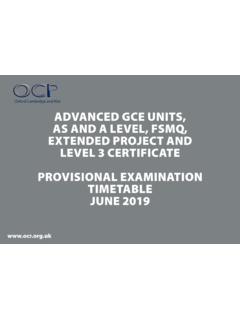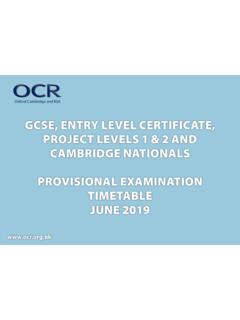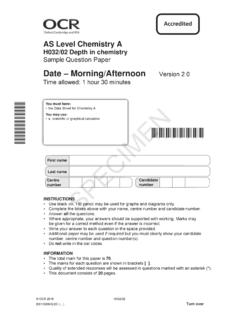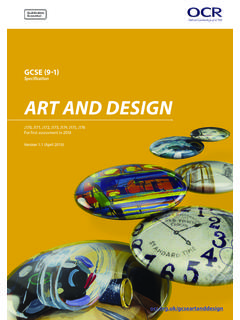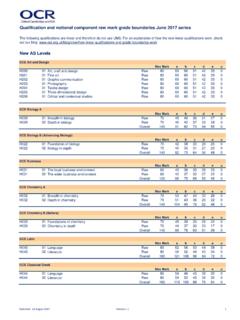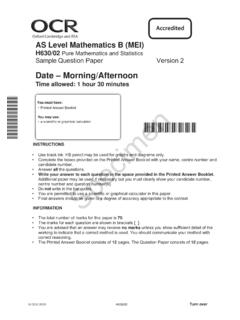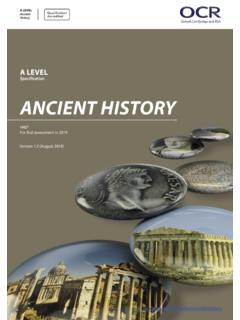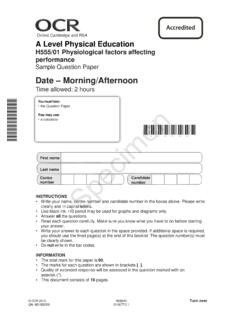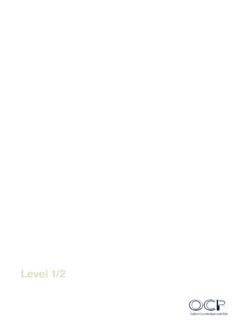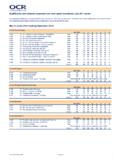Transcription of H432/01 Periodic table, elements and physical …
1 A Level chemistry A. H432/01 Periodic table , elements and physical chemistry Sample Question Paper Date Morning/Afternoon Time allowed: 2 hours 15 minutes You must have: the Data Sheet for chemistry A. You may use: a scientific or graphical calculator EN *. 0 0 0 0 0 0 *. IM. First name EC. Last name Centre Candidate number number SP. INSTRUCTIONS. Use black ink. You may use an HB pencil for graphs and diagrams. Complete the boxes above with your name, centre number and candidate number. Answer all the questions. Write your answer to each question in the space provided. Additional paper may be used if required but you must clearly show your candidate number, centre number and question number(s). Do not write in the bar codes. INFORMATION. The total mark for this paper is 100.
2 The marks for each question are shown in brackets [ ]. Quality of extended responses will be assessed in questions marked with an asterisk (*). This document consists of 28 pages. OCR 2016 H432/01 . [601/5255/2] DC ( ) Turn over 2. SECTION A. You should spend a maximum of 20 minutes on this section. Answer all the questions. 1 Which row shows the atomic structure of 55Mn2+? Protons Neutrons Electrons A 25 30 23. B 25 55 23. C 27 30 25. D 30 25 28. EN. Your answer [1]. 2 The Group 2 elements react with water, forming a solution and a gas. IM. Which statement is correct? A The reactivity of the elements decreases down Group 2. EC. B The pH of the solution formed increases down Group 2. C The reaction is a neutralisation. D The equation for the reaction of strontium with water is: SP.
3 2Sr + 2H2O 2 SrOH + H2. Your answer [1]. OCR 2016 H432/01 . 3. 3 Chloroethene, CH2=CHCl, is prepared in the presence of a solid catalyst using the equilibrium reaction below. CH2 ClCH2Cl(g) CH2=CHCl(g) + HCl(g) H = +51 kJ mol 1. Which change would result in an increased equilibrium yield of chloroethene? A increasing the pressure B increasing the surface area of the catalyst C increasing the temperature D use of a homogeneous catalyst Your answer [1]. EN. 4 The table below shows enthalpy changes of formation, fH. Compound TiCl4(l) H2O(l) TiO2(s) HCl(g). fH / kJ mol 1. IM. 804 286 945 92. What is the value of the enthalpy change of reaction, rH, for the reaction in the following equation? EC. TiCl4(l) + 2H2O(l) TiO2(s) + 4 HCl(g). A 63 kJ mol 1. B 53 kJ mol 1. SP. C +53 kJ mol 1.
4 D +63 kJ mol 1. Your answer [1]. OCR 2016 H432/01 Turn over 4. 5 Zinc reacts with copper(II) sulfate solution, CuSO4(aq). Which apparatus could be used to determine the effect of the concentration of CuSO 4(aq) on the rate of reaction? A balance B gas syringe C colorimeter D pH meter Your answer [1]. 6 The boiling point of hydrogen bromide is 67 C. The boiling point of hydrogen iodide is 34 C. EN. The different boiling points can be explained in terms of the strength of bonds or interactions. Which bonds or interactions are responsible for the higher boiling point of hydrogen iodide? IM. A covalent bonds B hydrogen bonds EC. C permanent dipole dipole interactions D induced dipole dipole interactions SP. Your answer [1]. 7 The 1st to 8th successive ionisation energies, in kJ mol 1, of an element in period 3 are: 1012 1903 2912 4957 6274 21 269 25 398 29 855.
5 What is the element? A Al B Si C P. D S. Your answer [1]. OCR 2016 H432/01 . 5. 8 Using the graph, what is the value of the pre-exponential factor, A, for the decomposition of N2O5? 2N2O5(g) 4NO(g) + O2(g). EN. IM. A s 1. EC. B s 1. C 105 s 1. D 1013 s 1. SP. Your answer [1]. 9 A solution of propanoic acid, CH3CH2 COOH, has a pH of at 25 C. What is [H+] in this solution? A 10 6 mol dm 3. B 10 4 mol dm 3. C 10 3 mol dm 3. D mol dm 3. Your answer [1]. OCR 2016 H432/01 Turn over 6. 10 The lattice enthalpy of calcium chloride can be calculated using three of the enthalpy changes below. Which enthalpy change is not required? A enthalpy change of solution of calcium chloride B enthalpy change of hydration of Cl ions C enthalpy change of formation of calcium chloride D enthalpy change of hydration of Ca2+ ions Your answer [1].
6 11 Which redox reaction contains the largest change in oxidation state for sulfur? EN. A H2SO4 + 8HI H2S + 4I2 + 4H2O. B S + O2 SO2. C S2O32 + 2H+ SO2 + S + H2O. IM. D S + 6 HNO3 H2SO4 + 6NO2 + 2H2O. EC. Your answer [1]. 12 NO(g), H2(g), N2(g) and H2O(g) exist in equilibrium: SP. 2NO(g) + 2H2(g) N2(g) + 2H2O(g). At room temperature and pressure, the equilibrium lies well to the right-hand side. Which of the following could be the equilibrium constant for this equilibrium? A 10 3 mol dm 3. B 102 mol dm 3. C 10 3 dm3 mol 1. D 102 dm3 mol 1. Your answer [1]. OCR 2016 H432/01 . 7. 13 Copper(II) ions form an aqueous complex ion, X, with chloride ions. Which statement about X is true? A X has optical isomers B X has a square planar shape C X has the formula CuCl42+. D X has a yellow colour Your answer [1].
7 14 Two tests are carried out on an aqueous solution of copper(II) sulfate, CuSO4(aq). Test 1: Addition of potassium iodide solution EN. Test 2: Addition of barium chloride solution Which of the following statements is/are true? 1: Test 1 produces an off-white precipitate and a brown solution. IM. 2: Test 2 produces a white precipitate. 3: Test 1 and Test 2 are both redox reactions. EC. A 1, 2 and 3. B Only 1 and 2. SP. C Only 2 and 3. D Only 1. Your answer [1]. OCR 2016 H432/01 Turn over 8. 15 Two students set up the equilibrium system below. CH3 COOC2H5(l) + H2O(l) C2H5OH(l) + CH3 COOH(l). The students titrated samples of the equilibrium mixture with sodium hydroxide, NaOH(aq), to determine the concentration of CH3 COOH. The students used their results to calculate a value for Kc.
8 The students' values for Kc were different. Which of the reason(s) below could explain why the calculated values for Kc were different? 1: Each student carried out their experiment at a different temperature. 2: Each student used a different concentration of NaOH(aq) in their titration. 3: Each student titrated a different volume of the equilibrium mixture. A. B. 1, 2 and 3. Only 1 and 2 EN. IM. C Only 2 and 3. D Only 1. EC. Your answer [1]. SP. OCR 2016 H432/01 . 9. BLANK PAGE. EN. IM. EC. SP. OCR 2016 H432/01 Turn over 10. SECTION B. Answer all the questions. 16 Ammonia is a gas with covalently-bonded molecules consisting of nitrogen and hydrogen atoms. (a) Show the electron configuration of a nitrogen atom using electron-in-box' diagrams. Label each sub-shell. 1s . [2]. (b).
9 EN. Ammonia can be made from the reaction of nitrogen and hydrogen in the Haber process. IM. N2(g) + 3H2(g) 2NH3(g) H = 92 kJ mol 1 Equation 1. What effect will increasing the temperature have on the composition of the equilibrium mixture and EC. on the value of the equilibrium constant? Explain your answer. SP.. [2]. OCR 2016 H432/01 . 11. (c) A chemist mixes together mol N2 with mol H2 in a sealed container. The mixture is heated and allowed to reach equilibrium. At equilibrium, the mixture contains mol N2 and the total pressure is 500 kPa. Calculate Kp. Show all your working. Include units in your answer. EN. IM. EC. SP. Kp = units [5]. OCR 2016 H432/01 Turn over 12. (d) A chemical company receives an order to supply 1010 dm3 of ammonia at room temperature and pressure. The Haber process produces a yield.
10 Calculate the mass of hydrogen, in tonnes, required to produce the ammonia. Give your answer to three significant figures. EN. required mass of hydrogen = tonnes [3]. IM. (e) (i) Hydrazine, N2H4, is used as a rocket fuel. Hydrazine can be prepared from the reaction of ammonia with sodium chlorate(I). There are two other products in the reaction. EC. Write an equation for this reaction. SP. [1]. (ii) Using the electron pair repulsion theory, draw a 3-D diagram of a molecule of hydrazine. Predict the H N H bond angle around each nitrogen atom. H N H bond angle: [2]. OCR 2016 H432/01 . 13. BLANK PAGE. EN. IM. EC. SP. OCR 2016 H432/01 Turn over 14. 17 Iodine monochloride, ICl, can react with hydrogen to form iodine. 2 ICl + H2 2 HCl + I2. This reaction was carried out several times using different concentrations of ICl or H2.
